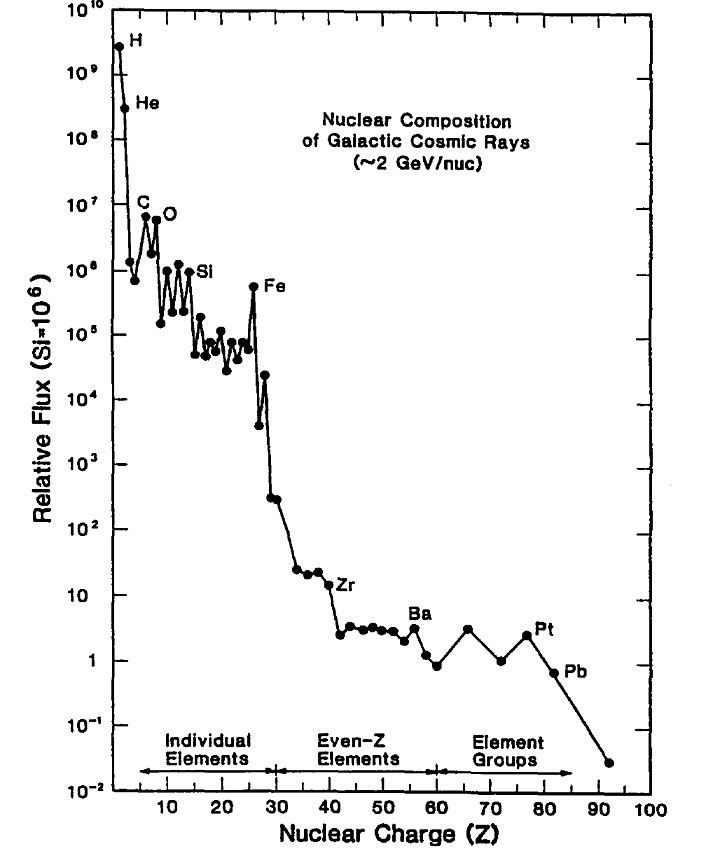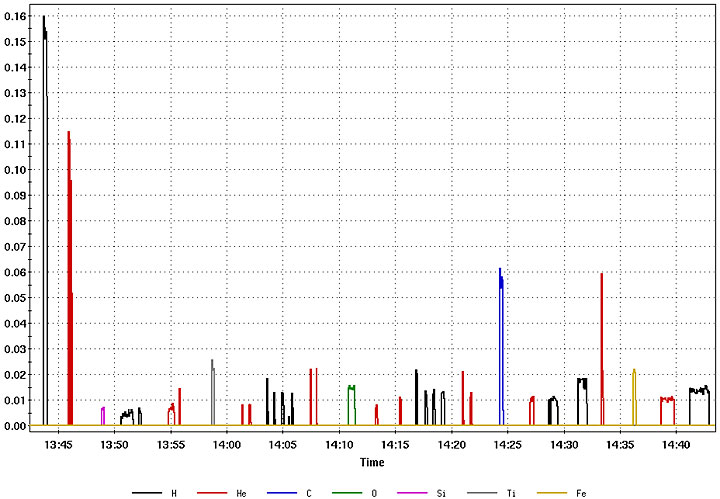NSRL User Guide: Biology Experiments
II. Operations
Galactic Cosmic Ray Simulation (GCRSim)
General Considerations
Galactic cosmic rays (GCRs) come from outside the solar system but generally from within our Milky Way galaxy. GCRs are atomic nuclei from which all of the surrounding electrons have been stripped away during their high-speed passage through the galaxy. GCRs have been accelerated to nearly the speed of light, probably by supernovae and coalescing neutron stars. The elemental makeup of GCRs is shown in Figure 1. (R.A. Medwaldt, Adv. Space Res. Vol. 14, No. 10, 1994.)
(R.A. Mewaldt, Elemental Composition and Energy Spectra of Galactic Cosmic Rays, in Interplanetary Particle Environment, Proceedings of a Conference, J. Feynman and S. Gabriel, editors, JPL Publication 88-28, 1988.)

Figure 1. Relative flux of cosmic ray nuclei as a function of nuclear charge, Z, at typcial energy of ~2 GeV/nuc.
At NSRL, Users can make use of the Galactic Cosmic Ray Simulation which is comprised of seven different species of ion, and fourteen different energies of H and He for 33 separate beams in a single GCRSim exposure. The exposures take approximately one hour. A sample of the GCR Simulation exposure is shown in Figure 2.

Figure 2.
The list of ions/energies and the fraction of the total dose delivered by each beam is given in the table below:
The GCR Simulation is delivered in a specific order, shown below, with series of H and He interleaved with a heavy ion:
Definition of the Full GCR Simulation
In order of delivery
| Ion | Energy (MeV/n) |
|---|---|
| H | 1000 |
| He | 1000 |
| Si | 600 |
| H | 20 |
| H | 23 |
| He | 20 |
| He | 23 |
| Ti | 1000 |
| He | 27 |
| He | 32 |
| H | 27 |
| H | 32 |
| H | 37 |
| H | 43 |
| He | 37 |
| He | 43 |
| O | 350 |
| He | 50 |
| He | 59 |
| H | 50 |
| H | 59 |
| H | 69 |
| H | 80 |
| He | 69 |
| He | 80 |
| C | 1000 |
| He | 100 |
| H | 100 |
| H | 150 |
| He | 150 |
| Fe | 600 |
| He | 250 |
| H | 250 |
Sorted by Ion and Energy
| Z | Ion | Energy (MeV/n) | Fraction |
|---|---|---|---|
| 1 | H | 20 | 6.08% |
| 1 | H | 23 | 1.34% |
| 1 | H | 27 | 1.48% |
| 1 | H | 32 | 1.60% |
| 1 | H | 37 | 1.74% |
| 1 | H | 43 | 1.86% |
| 1 | H | 50 | 2.00% |
| 1 | H | 59 | 2.12% |
| 1 | H | 69 | 2.22% |
| 1 | H | 80 | 2.24% |
| 1 | H | 100 | 5.44% |
| 1 | H | 150 | 7.00% |
| 1 | H | 250 | 13.77% |
| 1 | H | 1000 | 24.71% |
| 2 | He | 20 | 2.20% |
| 2 | He | 23 | 0.42% |
| 2 | He | 27 | 0.44% |
| 2 | He | 32 | 0.46% |
| 2 | He | 37 | 0.50% |
| 2 | He | 43 | 0.52% |
| 2 | He | 50 | 0.54% |
| 2 | He | 59 | 0.54% |
| 2 | He | 69 | 0.54% |
| 2 | He | 80 | 0.54% |
| 2 | He | 100 | 1.22% |
| 2 | He | 150 | 1.50% |
| 2 | He | 250 | 3.28% |
| 2 | He | 1000 | 4.98% |
| 6 | C | 1000 | 2.34% |
| 8 | O | 350 | 3.08% |
| 14 | Si | 600 | 1.62% |
| 22 | Ti | 1000 | 0.90% |
| 26 | Fe | 600 | 0.82% |


